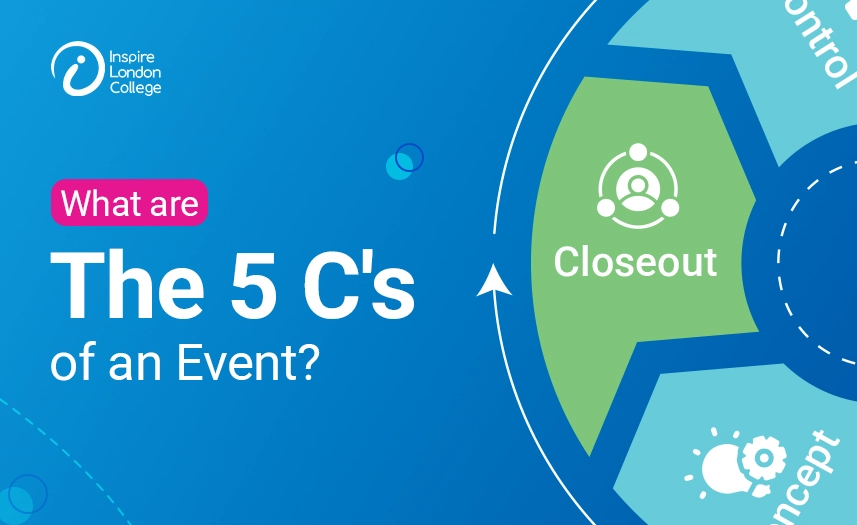The process of planning events requires precise attention to detail alongside strategic mental abilities and proper coordination skills. An established methodology guarantees successful organising of corporate conferences alongside weddings and charity fundraisers. One common question that arises in event planning is: What are the 5 C’s of an event?
The 5 C’s, including Concept, Coordination, Control, Culmination, and Closeout serve as the foundation of effective event management. They guide planners through every stage, ensuring a smooth and impactful experience for guests. In this article, we’re going to cover the 5 C’s of an event, which are a great starting point for putting your plan together.
Why are the 5 C’s important?
The 5 C’s of event planning play a crucial role in ensuring a successful and well-organised event. This framework helps event planners consider and address all key aspects, increasing the likelihood of success.
Organisers can enhance guest satisfaction, creating a positive and enjoyable experience for attendees, by focusing on essential elements, such as content, communication, and coordination. A well-planned event with a clear concept and engaging content is more likely to achieve its objectives, ultimately maximising return on investment.
Additionally, the structured approach of the 5 C’s helps planners stay organised and focused, improving overall efficiency. By following this, event organisers can create impactful events that meet their goals and leave a lasting impression on their guests.
The 5 C’s of an event
1. Concept:
The first and most important C of an event is the concept.Every event begins with an idea. The concept phase is where the vision for the event takes shape. Your concept should be clear, concise, and inspiring. This stage involves defining the purpose, objectives, and target audience for the event. Without a clear concept, an event lacks direction and fails to meet its planned goals.
Key Elements of Concept
A well-defined concept guarantees that all components of the event are consistent with the objectives. It supports marketing, branding, and general planning. Without an engaging concept, an event may not be coherent, which would reduce participation and effect.
The key elements of the concept are as follows:
- Event’s Purpose: Why is the event being held? Is it for networking, education, celebration, fundraising, or product promotion? A clear purpose helps in making decisions regarding format, content, and engagement strategies.
- Identifying the Target Audience: Designing an event that suits guests’ preferences requires an understanding of their demographics, interests, and expectations. A well-defined audience ensures effective marketing and a higher engagement rate.
- Setting the Event Theme: The theme should align with the purpose and audience. It influences branding, decorations, speakers, entertainment and overall atmosphere. A strong theme makes the event more cohesive and memorable.
- Choosing the Right Venue: Location is important for accessibility and attendance. The goal of the event and the expectations of the audience should guide the selection of elements, such as ambiance, transportation, facilities, and capacity.
2. Coordination:
The second step is coordination, which involves organising the logistics of the event, such as booking a venue, arranging catering and transportation, and hiring staff. A solid plan with a timeline should be created to ensure that everything runs smoothly.
Key Elements of Coordination
Careful coordination is crucial for turning your event idea into reality. It involves managing all the logistical details, ensuring everything runs smoothly, and dealing with any unexpected issues that may arise. Effective coordination guarantees a favourable experience for participants and helps avoid expensive errors. The key elements of coordination include:
- Team Management: Efficiently distributing tasks by designating specific roles and responsibilities to team members or hiring professional event planners guarantee smooth coordination and implementation. A well-structured team includes an event manager, logistics coordinator, marketing specialist, and guest experience manager.
- Selecting and Coordinating Vendors: Finding reliable suppliers for catering, decor, audio, lighting, and entertainment can help improve the overall event experience and guarantee a smooth production. Building strong relationships with reliable vendors ensures smooth event execution and cost efficiency.
- Scheduling: Scheduling includes creating a clearly organised and comprehensive timeline that highlights essential activities like venue preparation, guest arrivals, and planned performances in order to guarantee a flawless and well-organised event flow. This includes planning transportation for guests and ensuring equipment and materials are delivered on time.
- Marketing and Promotions: Using social media, email campaigns, marketing, and influencer collaborations can increase event visibility and reach a larger audience. An effective marketing strategy helps maximise attendance and engagement.
3. Control:
Control is the third stage of event management and is about monitoring and adjusting operations to ensure the event runs smoothly. It involves on-site management, troubleshooting, and maintaining the event’s quality and safety. Without proper control, the 5 C’s of an event framework cannot function effectively.
Key Elements of Control
Control prevents mishaps, ensures the event runs on schedule, and provides a professional experience for guests. It enables event managers to make immediate decisions and modifications to ensure smooth execution. Let’s have a look at the key elements of control:
- On-Site Supervision: The event coordinator must direct setup operations while managing guest check-ins and ensuring service coordination to maintain program flow and schedule adherence.
- Communication Methods: A system of efficient team communication requires team members to use radios together with group chats or event apps to maintain real-time updates and smooth coordination.
- Security and Crowd Management: Safety protection for event guests will be ensured through security staff together with medical stations and emergency exit markers which must be easily visible. This also involves managing crowd flow, keeping an eye out for any possible disturbances, and blocking illegal access.
- Technical Supervision: Supervising the setup and operation of sound systems, lighting, presentations, and virtual streaming help provide a flawless and engaging event experience. Backup plans for equipment failures must be prepared to avoid disruptions.
4. Culmination:
Culmination is the event day itself and is the most critical part during which you and your team must be well-prepared and organised. All the planning and preparations are focused on this day, so it’s crucial to have a capable team that can handle any unforeseen challenges and ensure the smooth running of the event.
Key Elements of Culmination
Culmination focuses on the lasting impact of the event. It’s about creating a memorable experience that achieves the event’s goals, whether it’s generating leads, building relationships, or raising awareness. A strong culmination ensures the event has a positive and lasting impact on attendees and organisers alike. The key elements of culmination includes:
- Guest Management: The management of smooth check-ins and effective seating arrangements alongside prioritising guest comfort brings about an improved event experience for all participants. This includes welcoming guests, directing them to their designated areas, and ensuring their needs are fulfilled throughout the event.
- Program Flow: The excellent delivery of planned activities included smooth coordination between speeches, performances and networking events, which resulted in an organised participatory event. A carefully organised schedule guarantees that the event unfolds smoothly without avoidable holdups.
- Engagement Techniques: Using interactive features, such as live polls together with Q&A sessions and social media engagements adds giveaways to raise attendee involvement, which increases the event quality. Keeping the audience engaged ensures a more memorable and impactful experience.
- Troubleshooting problem: Quick involvement in technical, logistical, and guest difficulties at the event enables staff to maintain a smooth, problem-free experience. This includes resolving sound system failures, seating disputes, or last-minute changes to the program.
- Hospitality and Catering: Ensuring proper catering management, dietary accommodations, and timely serving contribute to a smooth guest experience.
5. Closeout:
The final step in what are the 5 C’s of an event is the closeout phase that ensures all post-event activities are completed and lessons are learnt for future improvement. Closing out properly helps in building relationships with vendors, sponsors, and guests. It also provides valuable insights for improving future events, ensures all loose ends are tied up, and helps in maintaining a professional reputation in the event industry.
Key Elements of closeout
Let’s explore some essential key elements of closeout:
- Cleaning: Make sure vendors pack up their equipment, the venue is cleaned and restored, and all waste is disposed of properly.
- Event Evaluation: This includes obtaining important data about event success by gathering feedback directly from attendees, staff, stakeholders, and assessment surveys to identify improvement opportunities for future events.
- Financial balance: The organisation must ensure that all invoices are paid quickly and financial processing works efficiently while maintaining thorough documentation in order to preserve accurate financial information.
- Team discussion: The event team must engage in a formal debriefing session that facilitates the assessment of effective practices, acknowledges faced challenges, and develops improvement strategies for upcoming events.
- Data Analysis and Reporting: The collection and examination of event data via attendance figures, engagement metrics, and financial reports allow for accurate assessment of return on investment concerning the event’s impact.
Conclusion
The 5 C’s of an event, including concept, coordination, control, culmination, and closeout form the essential framework for successful event planning and execution. Event planners can create seamless and memorable experiences for attendees by carefully following these steps. Whether you are hosting a small corporate gathering or a large-scale festival, understanding what are the 5 C’s of an event guarantees that your event is not just an occasion but an unforgettable experience.



